4, Experimental conclusion
1. Experimental task 1
Experimental source code
assume cs:code, ds:data data segment x db 1, 9, 3 len1 equ $ - x y dw 1, 9, 3 len2 equ $ - y data ends code segment start: mov ax, data mov ds, ax mov si, offset x mov cx, len1 mov ah, 2 s1:mov dl, [si] or dl, 30h int 21h mov dl, ' ' int 21h inc si loop s1 mov ah, 2 mov dl, 0ah int 21h mov si, offset y mov cx, len2/2 mov ah, 2 s2:mov dx, [si] or dl, 30h int 21h mov dl, ' ' int 21h add si, 2 loop s2 mov ah, 4ch int 21h code ends end start
Running screenshot

Question 1: the disassembly screenshot is as follows:
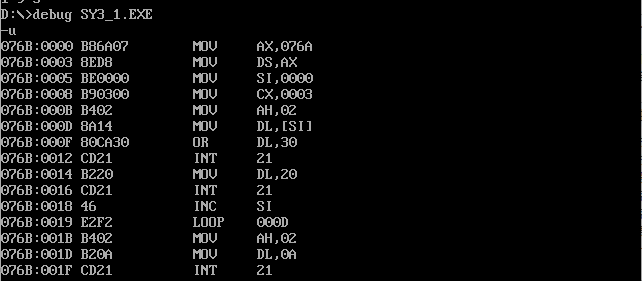
As you can see, loop s1 After disassembly loop 000D That is, the jump address is 000d, the jump is based on the displacement, and the jump rule is Current IP + offset = jump address , The current IP is 001B, converted to decimal is 27, the jump address is 000d, converted to decimal is 13, and the offset that can be calculated is - fourteen .
From the perspective of CPU, you can view the stored content and find that the stored content is F2 ,
Convert to binary 1111 0010 , and - fourteen The complement of is 1110 0010 , It happens to be F2, so the CPU stores the offset and calculates the instruction address after the offset according to the IP value.
Question 2: the disassembly screenshot is as follows:

As you can see, loop s2 After disassembly loop 0029 That is, the jump address is 0029. The jump is based on the displacement, and the jump rule is Current IP + offset = jump address , The current IP is 0039, converted to decimal is 57, the jump address is 0029, converted to decimal is 41, and the offset that can be calculated is - sixteen .
From the perspective of CPU, you can view the stored content and find that the stored content is F0 ,
Conversion to binary is 1111 0000 , and - sixteen The complement of is 1111 0000 , It happens to be F0, so the CPU stores the offset and calculates the instruction address after the offset according to the IP value.
Question 3: the disassembly screenshot has been given
2. Experimental task 2
Program source code
assume cs:code, ds:data data segment dw 200h, 0h, 230h, 0h data ends stack segment db 16 dup(0) stack ends code segment start: mov ax, data mov ds, ax mov word ptr ds:[0], offset s1 mov word ptr ds:[2], offset s2 mov ds:[4], cs mov ax, stack mov ss, ax mov sp, 16 call word ptr ds:[0] s1: pop ax call dword ptr ds:[2] s2: pop bx pop cx mov ah, 4ch int 21h code ends end start
Screenshot of debugging and disassembly:
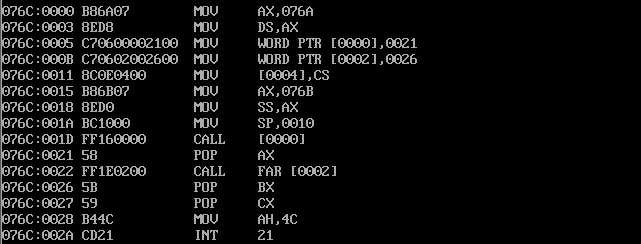
(1) Theoretical analysis, before the program exits, ax=21, bx=26, cx=076c.
(2) debug debugging and verification, and the result is
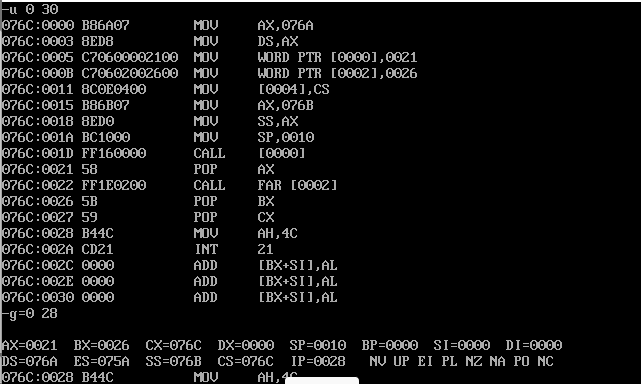
The results are consistent with the theoretical analysis
3. Experimental task 3
Program source code
assume cs:code, ds:data data segment x db 99, 72, 85, 63, 89, 97, 55 len equ $ - x data ends code segment start: mov ax, data mov ds, ax mov si, offset x mov cx, len s: mov ah, 0 mov al, [si] call printNumber call printSpace inc si loop s mov ah, 4ch int 21h printNumber: mov bx, 10 div bl mov bx, ax add bx, 3030h mov ah, 2 mov dl, bl int 21h mov ah, 2 mov dl, bh int 21h ret printSpace: mov ah, 2 mov dl, 20h int 21h ret code ends end start
Screenshot of running test

Consistent with expected requirements
4. Experimental task 4
Program source code
assume cs:code, ds:data data segment str db 'try' len equ $ - str data ends code segment start: mov ax, data mov ds, ax mov si, offset str mov cx, len mov bl, 0ah mov bh, 0 call printStr mov cx, len mov si, offset str mov bl, 0ch mov bh, 24 call printStr mov ah, 4ch int 21h printStr: mov al, 00a0h mul bh mov di, ax mov ax, 0b800h mov es, ax mov al, bl s: mov ah, ds:[si] mov es:[di], ah; mov es:[di+1], bl; add di, 2 inc si loop s ret code ends end start
Screenshot of running test
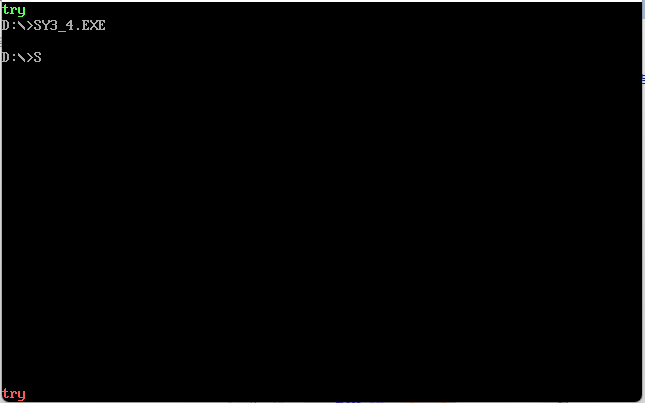
The experimental results are in line with expectations
5. Experimental task 5
Program source code
assume cs:code, ds:data data segment stu_no db '201983290270' len =$ - stu_no data ends code segment start: mov ax, data mov ds, ax mov si, offset stu_no mov cx, len mov ax, 0b800h mov es, ax mov di, 0 mov al,24 mov dl, 80 mul dl mov cx, ax s: mov al, 17h mov es:[di], byte ptr 20h mov es:[di+1], al add di, 2 loop s mov ax, 80 sub ax, len mov dl, 2 div dl mov cx, 0 mov cl, al mov bx, cx call gang mov cx, len s2: mov al, ds:[si] mov ah, 17h mov es:[di], ax add di, 2 inc si loop s2 mov cx, bx call gang mov ah, 4ch int 21h gang: s1: mov al, '-' mov ah, 17h mov es:[di], ax add di, 2 loop s1 ret code ends end start
Screenshot of running test
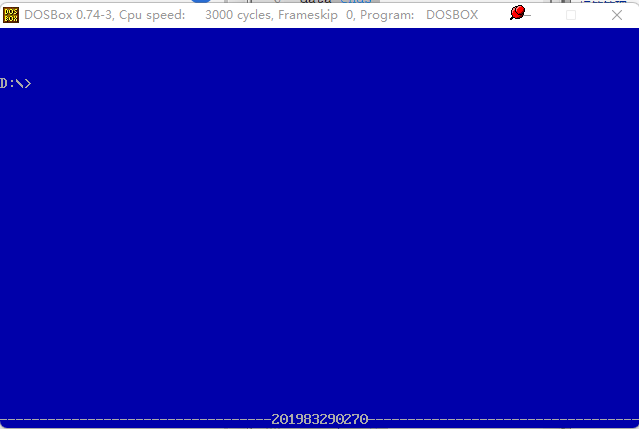
The experimental results are consistent with expectations.
5, Experimental summary
Through this experiment, I have mastered the use of jump instruction, the writing of subroutine and the method of displaying characters. I use call instruction and ret instruction to realize the writing of subroutine. The window displays 25 lines and 80 columns.